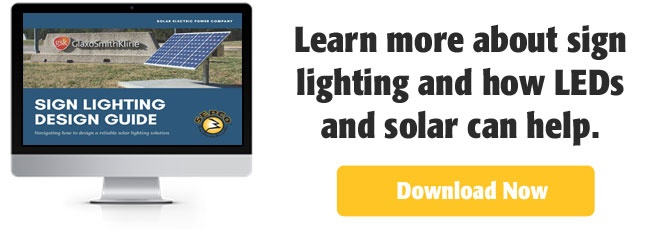The Ultimate Guide to Solar Sign Lighting
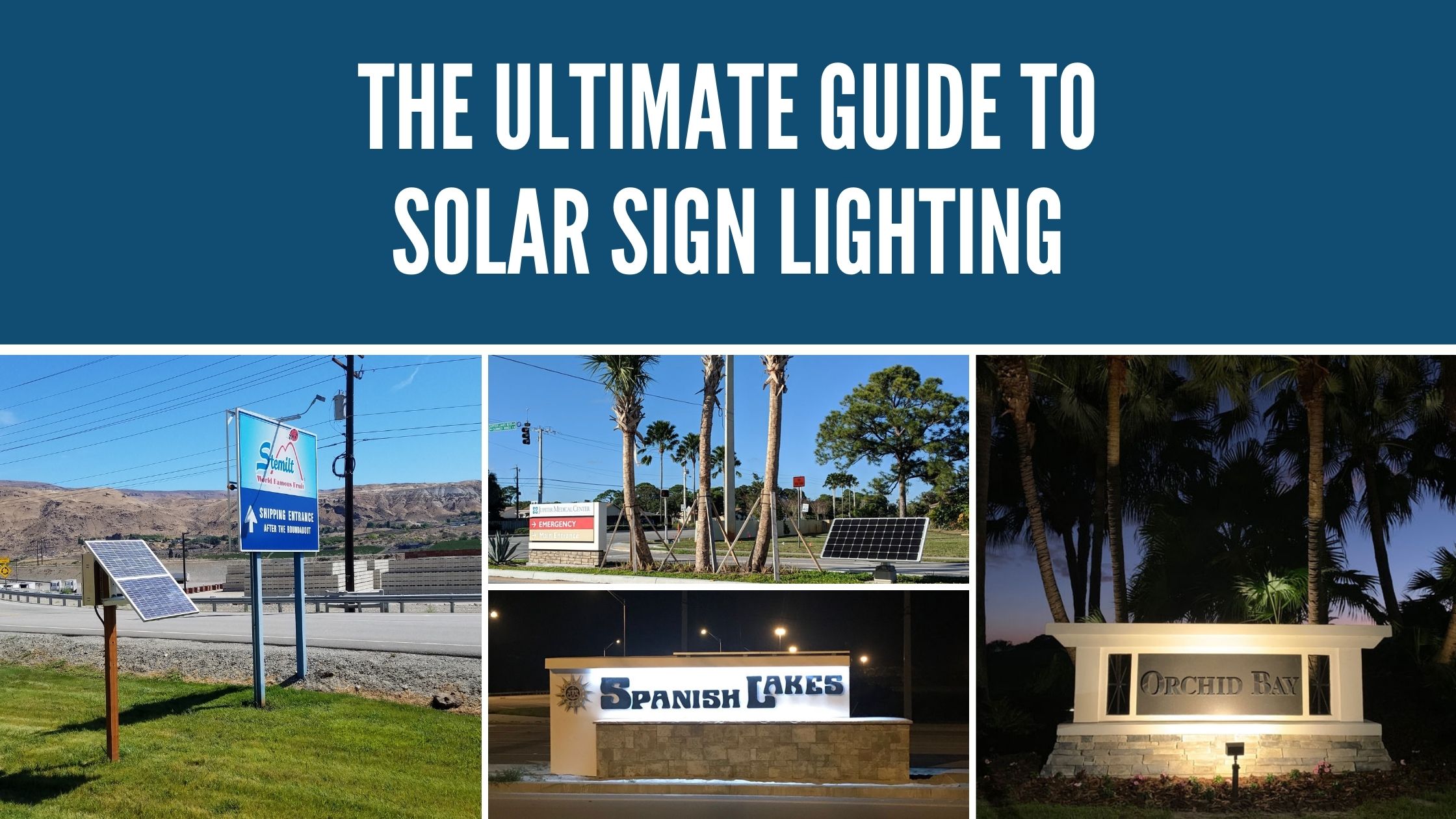
Contents
Signs are used around the world to convey information and communicate with people. Signs can be used to show a location, mark an entrance or exit, give directions, or provide helpful information to people passing by. Some signs require illumination to allow people to see the sign at night, others are made from reflective materials, and many are just not illuminated at all for one reason or another.
This guide will walk you through the various types of signs, how you can illuminate them, how solar plays a part in the illumination of a sign, how to size up a solar solution, and finally a comparison between commercially designed custom solutions to solar lights you can find at any big box retailer. We hope this guide gives you a comprehensive understanding of signs and how they should be illuminated.
What Makes a Sign
There are so many types of signs. In this section, we will cover signs that require illumination in one way or another. This doesn't necessarily mean that each and every one of them will have lighting, but they are the most common signs to require a light system.
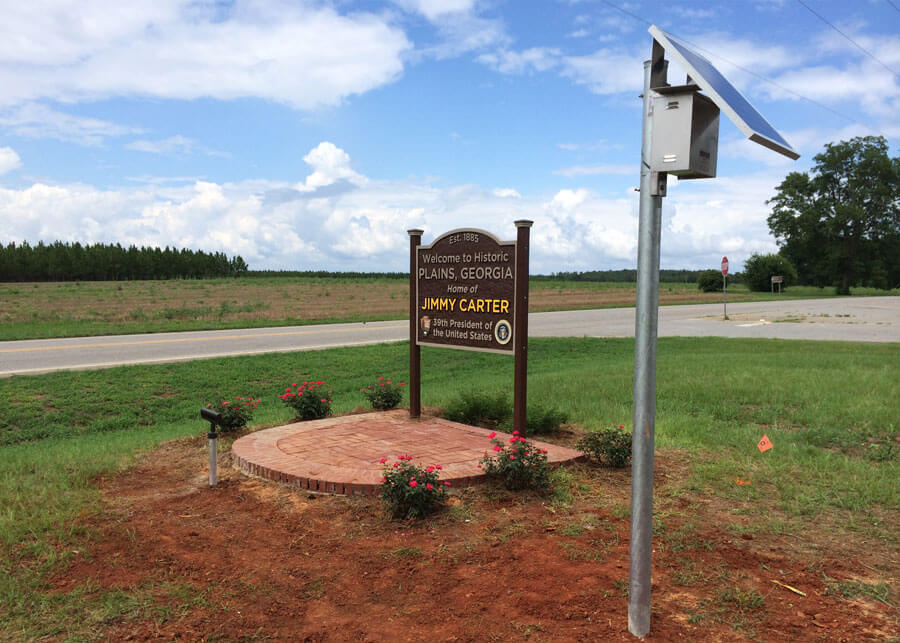
Small Directional Signs
Most small directional signs provide information about a site, either using arrows, marking a spot, or showing the entrance or exit to a site. These signs are usually relatively small, around 5 feet square or less. They typically aren't very decorative and only require one small light fixture to cover the area.
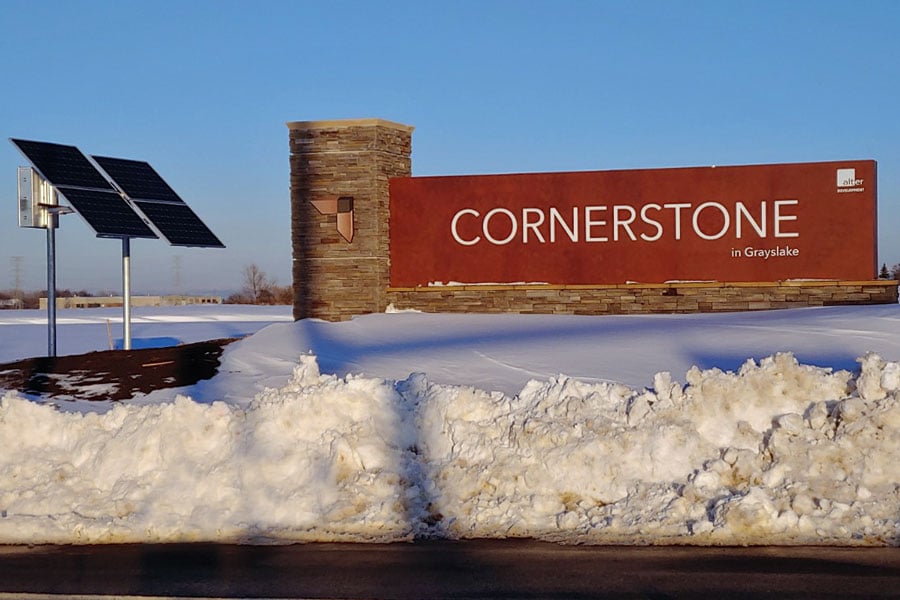
Large Monument Signs
A larger monument sign is usually more decorative and provides a marker to the entrance of an area, say to a city or municipality or a community / HOA. These can require one or more fixtures to illuminate the sign fully and usually have some decorative features surrounding it, such as landscaping or trees.
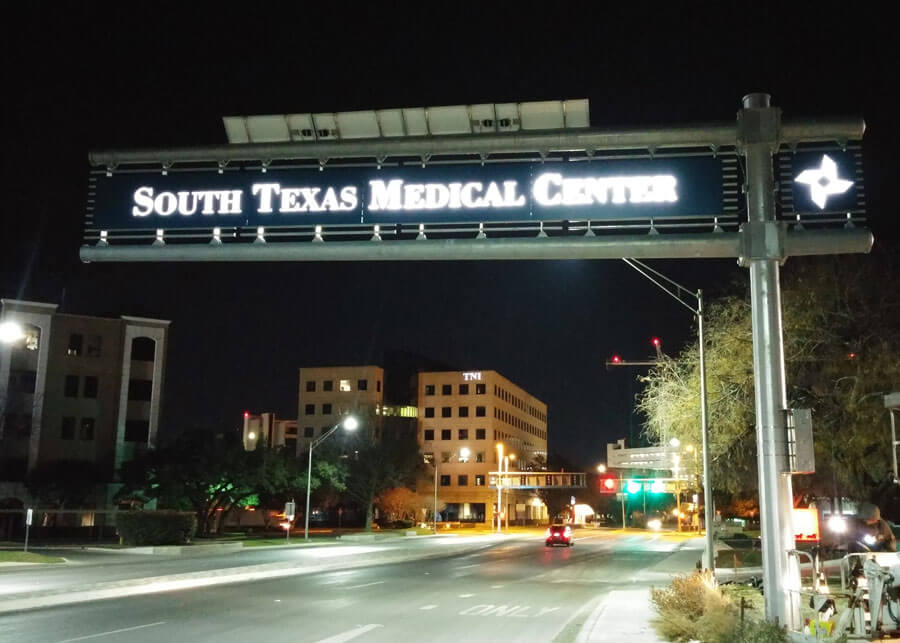
Sign Cabinets
Sign cabinets are similar to small directional and large monument signs; however, they use an acrylic panel with graphics mounted to the face of the sign cabinet. These are great for spaces that need to portray the same information on both sides or to easily be changed out, like for a pylon application at a shopping center.
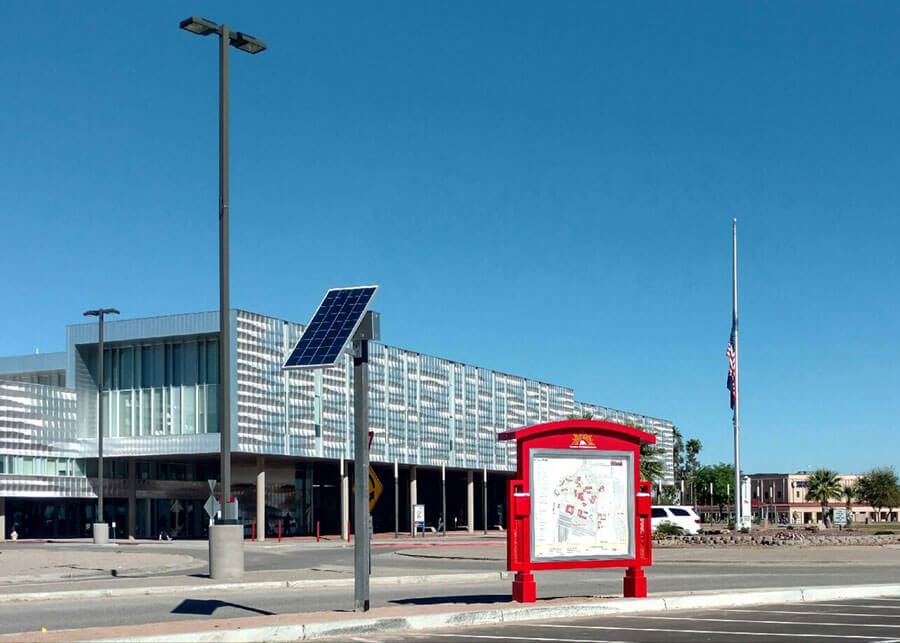
Kiosks
Sign kiosks are commonly found in public places such as shopping malls, airports, train stations, and museums. They often provide directions, display advertisements, promote products or services, showcase upcoming events, or broadcast news and weather updates. Sign kiosks typically have a long linear light or can have a backlit panel. The structure sometimes has a roof, but not in every case.
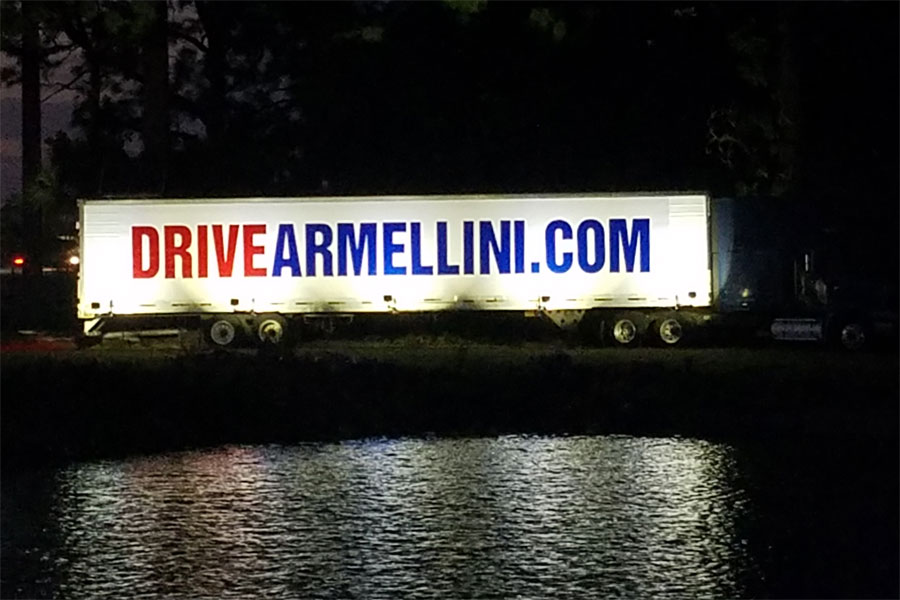
Billboards
Billboards are large signs found typically along highways and interstates. Many billboards already utilize solar as they are sometimes located on property not owned by the billboard company and therefore cannot access power. These large structures usually require several fixtures to illuminate the face evenly; however, since they are typically in such remote locations without much ambient light, lower-level lights are able to be utilized to provide the lighting for travelers to see.
Why Should You Illuminate a Sign
Having a sign installed is only the first step. After the installation, you should ensure the sign is properly illuminated. Illuminating a sign can provide several benefits:
- Visibility: Illuminating a sign makes it more visible, especially in low-light conditions or at night. This can be important for safety reasons, such as for traffic signs, directional signs, or emergency exit signs.
- Attract attention: Illuminated signs can help attract attention and stand out in a crowded environment. This can be important for businesses or organizations that want to draw attention to their location, products, or services.
- Branding: Illuminated signs can also help reinforce a brand's identity and create a memorable impression on customers. For example, a well-lit and prominently displayed logo can help create a strong association between the brand and the product or service.
- Aesthetics: Illuminated signs can also enhance the aesthetic appeal of a location, creating an inviting and welcoming atmosphere. This can be important for public spaces like parks, plazas, and shopping centers.
Overall, illuminating a sign can improve its visibility, attract attention, reinforce branding, and enhance the aesthetic appeal of a location.
There are instances where you cannot illuminate a sign with traditional power. This is because of a lack of infrastructure at the sign location, or it may be too costly to trench out the electrical lines. Either way, solar can play a big part in illuminating the sign structure.

Why Use Solar for Your Next Sign
Why would you want to use a solar lighting solution for your next sign? This is a good question! Solar is suitable for applications where traditional energy isn't available or is very costly to bring to the site. For example, if you have a sign being installed in the median of a large roadway, trenching the power underground causes problems with traffic, has the potential to disrupt the area, and is very costly to route. And depending on where the power needs to be routed from, these high-powered transmission lines can be costly.
Off-grid solar lighting systems for signs are perfect for these types of installations. They can provide a source of electricity that is directly for the sign itself. It also uses low-voltage DC power and low-power lines which are much less expensive. These systems also allow for no additional electric bills or energy usage from dirty energy sources.
Solar is also great for companies or areas wanting to showcase their green initiatives. If a company is looking to use solar, this is an excellent opportunity for them to dip their toes in without jumping into a huge grid tie system installed on their building. Instead, they can get a feel for what solar requires, help them understand a little bit about the solar industry, and work with a company that can educate them.
Sizing Up the Solar for Your Sign
Only a few steps and pieces of information are required to size up a solar solution for a sign. Since signs are quite simple, unlike many other solar lighting applications, putting the system together doesn't take much. The information that needs to be gathered includes:
- Where is the sign going to be installed?
- What are the dimensions of the sign?
- Is the sign going to be flood illuminated or internally illuminated?
- If flood illuminated, is the sign single or double-sided?
- If internally illuminated, what LED module and how many?
- How long per night does the sign need to operate?
- Any other requirements or restrictions for the project?
Let's dive a little deeper into each question and why gathering the information is critical to developing the correct system to meet the project's needs.
Where is the sign going to be installed?
This is requesting the project city and state to gather the available solar insolation, sun hours, and the length of the night in the location. This is important since understanding how much solar is available at the location will govern the entire project. Areas with more solar availability can operate at a much higher wattage than areas with less solar. Sometimes multiple solar units are used to illuminate large signs, like large internally illuminated signs or large billboards.
The other reason for the location is to see if there are any obstacles to the solar. This includes shading concerns, southern exposure, and just a general idea of the best location for the solar unit. Sometimes the solar can be placed right next to the sign; however, there are a few cases where the sign is located in a space with lots of landscaping and trees, even buildings or other issues.
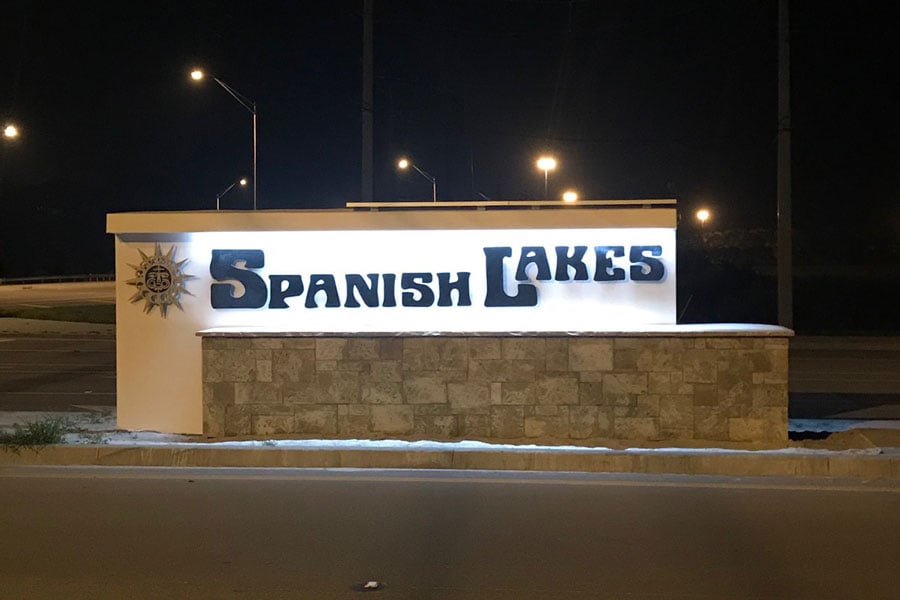
What are the sign's dimensions?
Understanding the sign's dimensions is key for flood lighting a sign. Most floodlights offer a good amount of coverage for 10-foot square areas. This obviously depends on many factors but it is an excellent general rule of thumb to start with.
Therefore, if the sign is smaller, lower wattages can be used to achieve the same light levels as larger signs. Larger monument signs that don't have much but stone columns on the side may not necessarily need as many fixtures as other monument signs. Drawings are also helpful in determining how to best set up the lights.
Finally, if the sign is single-sided, only one or two fixtures will be used, but if double-sided, ensuring there are enough fixtures to illuminate both sides of the sign properly is critical. Make sure to provide this information.
Floods or LED Modules
There are two main ways to illuminate a sign. Floods, like those mentioned above, and LED modules for internal illumination or halo glow. LED modules tend to have a higher power requirement due to the nature of how internal signs work. There need to be many LED modules to illuminate the same area one flood typically can cover.
Internal LED modules, like that from Sloan, Principal, GE, Hanley, or another manufacturer, would be powered directly by the DC power provided by the solar; no AC power would be used. This allows for the power supply to be removed and the actual wattage is then calculated to determine the solar. However, this is not standard for most sign companies, so working with a solar professional to assess the needs of the sign and how to adjust it to meet the solar requirements better is key to providing the correct system.
How Long to Light the Sign
Some signs require dusk to dawn illumination because of the nature of the sign, such as an entrance sign to a city or municipality, community, or other such space. Other signs, like that of an office space, can be shut off after midnight or so, depending on the traffic of the area. Signs are great for marketing, but most companies are closed after midnight and do not need to advertise afterward.
Having a sign illuminated from dusk to dawn will typically use the largest solar power assembly to operate, whereas having the lights shut off after a set time, reduces the solar requirement. The reduction in solar can make or break a project financially. It can also allow brighter lights to be used since the system has more wiggle room.
Everything Else
All other project requirements and restrictions should be presented to the solar professional at the beginning of the project. This allows them to consider everything that will need to be dealt with, either with system sizing, operation, placement of solar, etc. Changing the specification because something was forgotten later on can cause issues and miscommunications. Likewise, changing the system operation or requirements after the system has been purchased and installed can cause problems for the sign company and solar manufacturer.
Commercially Design Systems vs. Big Box Retailers
There are two types of solar units on the market today – one that is manufactured by a custom solution provider like us here at SEPCO and online or big box retailers that import their products with a mentality that one size fits all. This has caused waves of frustration in the solar industry where people are installing these cheap systems that aren't appropriately designed; then, when they don't work, they tell everyone that solar doesn't work. Solar does work, but you have to be more diligent when it comes to an off-grid solution.
Commercially designed systems consider every piece of information when sizing up the system. The manufacturer looks at details that are overlooked in many cases by people who do not work in the solar industry. This attention to detail ensures that the system will operate properly and not have issues a year into the system operation. Most manufacturers also provide much longer warranty periods and better customer support in the future.
Big box retailers and online vendors do not have any reason to support their system. They are in it to make money and will leave you high and dry when any issues arise. These types of retailers expect their customers to return to the manufacturer, which is often unknown or has changed so many times that there is no way to get support.
Making sure you purchase a system from a company that has been in business for as long as, or longer than, their systems are warrantied for, will guarantee that they will stand behind their product and have the ability to service and assist installed systems for many years to come.
In conclusion, lighting a sign is essential for visibility, safety, and branding purposes. Illuminated signs can attract attention, reinforce a brand's identity, and create an inviting atmosphere. Solar-powered lighting is an excellent solution for ensuring that a sign is well-lit, even in areas where access to electricity is limited or unreliable. In addition, solar sign lighting is an eco-friendly and cost-effective option for lighting signs by harnessing the sun's power. Furthermore, it can be easily installed without expensive infrastructure and maintenance costs. Overall, solar-powered lighting is an effective and sustainable solution for illuminating signs, improving their visibility and ensuring they serve their intended purposes effectively.

